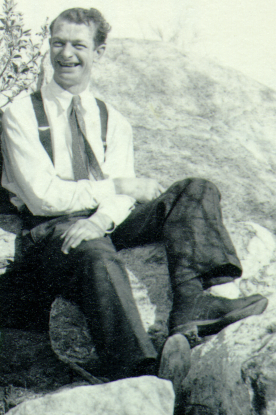 Linus Pauling, 1931.
Linus Pauling, 1931.[Part 2 of 7]
“The nature of the chemical bond. II. The one-electron bond and the three-electron bond.” Journal of the American Chemical Society, September 1931.
Linus Pauling’s first paper on the nature of the chemical bond made huge waves throughout the field, catching the attention of many. The second paper in the series however, was not quite so memorable. In it, Pauling tried to use quantum mechanics to explain molecules formed by either one- or three-electron bonds. This work stood in contrast to his first paper, which focused solely on electron pair bonds. And though they were similarly novel to Pauling’s first article, the ideas put forth in the second paper did not stand the test of time.
The single-electron and three-electron bonding environments had long proven difficult for chemists to understand. In tackling the challenge, Pauling admitted at the outset that they, “have not the importance of the electron-pair bond, for they occur in only a few compounds.” Nonetheless, they were “of special interest on account of their unusual and previously puzzling properties.”
Pauling’s first step in approaching the problem was to focus first on single-electron bonding, after which he would then apply the rules and mechanisms that he had formulated to the three-electron bond. Like all of the papers in his nature of the chemical bond series, the foundational groundwork for his ideas was based in quantum mechanics.
Accordingly, he began his explanation of the one-electron bond by delving into quantum mechanical principles. In doing so, Pauling argued that resonance – which, simply stated, is the sharing of energies, and a concept that Pauling would detail in greater depth in his fifth paper – could be predicted to arise if two different theoretical states of a bond possessed equal energy.
For example, the two possible bonding states for H2+ were H· H+ and H+ H·. Given that the two configurations possessed equal energies, Pauling put forth that resonating bonds between the two would be found with “essentially the same energy.” In other words, the one-electron bonds holding H2+ together were actually resonating between two different configurations. The mechanisms underlying three-electron bonds were detailed in much the same way.
After offering this explanation for how these bonds might form, Pauling used the rest of his paper to apply the mechanism to known molecules. In doing so, Pauling noted that, to date, it had been difficult to determine which molecules even possessed one- or three-electron bonds. Both types of bonds were known to exist, but this was mostly because observed energy levels for certain compounds were much more stable than would be predicted by models using other types of bonds.
For compounds suspected to be of this type, Pauling used resonance to demonstrate equivalence between observed bond energies and theoretical bond energies. Success in showing that the two sets of bond energies were equal or “differ[ing] by only one or two volt-electrons” would mean that the “criterion for the formation of a one-electron [or three-electron] bond is satisfied,” thus validating his ideas.
In his paper, Pauling applied his theory specifically to the boron hydrides. Once again based upon compatibilities between observed and predicted energy values for these compounds, Pauling found his criteria to be met and concluded that “the one-electron bond is to be expected.” In later years, as Pauling’s thinking matured, his views on these compounds became more sophisticated. But at the time of the second paper, he argued that the hydrogen ion (H+3), and the triatomic hydrogen ion (H+3) in the boron hydrides must be single-electron bonds based on their observed energy levels.
Pauling likewise suggested that the oxygen molecule, the helium ion (He+2), and nitric acid (NO), were all formed by three-electron bonds. For oxygen in particular, Pauling believed that a three-electron bond was required to explain the molecule’s slight magnetic moment. This connection between magnetism and electron bonding was something that Pauling had addressed in his first paper, and remained a topic to which he would turn with some frequency throughout the seven paper series.
As time moved forward, many of the notions put forth in Pauling’s second paper were largely debunked, with Pauling himself eventually speaking out about their irregularities. The primary issue with the work was its reliance upon Molecular Orbital theory to explain how double and triple bonds work. At this early stage in Pauling’s career, Molecular Orbital theory and Valence Bond theory did not stand apart as distinct models and, as such, Pauling’s thinking sometimes blended the two. Later, of course, Pauling’s writings would prove foundational to the advancement of Valence Bond theory.
Despite their limitations, the concepts introduced by the second paper were still important in helping Pauling to frame the larger thrust of his series. Though he sometimes went astray, Pauling more commonly found success in building off of concepts from his preceding papers in his work to create a fundamental understanding of the nature of the chemical bond.
